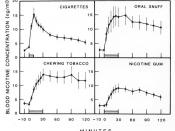History: European explorers who arrived in the Western Hemisphere in the 1500s observed Native Americans smoking tobacco plant leaves in pipes. The colonists who followed them grew tobacco plants as a cash crop for export, and smoking became part of European culture by the 1600s. Most tobacco was consumed in pipes and cigars or as snuff (finely pulverized tobacco inhaled into the nostrils). This pattern changed by the early 20th century, by which time smokers consumed more than 1,000 cigarettes per capita each year in the United States and some European countries.
Inhaling the smoke of tobacco leaves. Tobacco contains the drug nicotine, which is a stimulant and can be addictive, as well as tar and other toxic substances. Smoking has been proved to cause lung cancer and cancers of the mouth, larynx, and oesophagus; chest diseases, such as bronchitis and emphysema; and to contribute to heart disease. Women smokers have a higher risk of diseases of the circulatory system, particularly if smoking is combined with the contraceptive pill; smoking during pregnancy may put the unborn baby at risk, or lead to lighter birth weight.
The main ingredient tobacco is an annual or short-lived perennial plant, Nicotiana tabacum, which produces a spiral of large leaves on a stout stem about 2 m (6.5 feet) tall. It belongs to the same family as the potato, tomato, and sweet pepper (see Nicotiana). Native to tropical America, it is now cultivated throughout the world, with the USA being the largest producer. Tobacco plants may be harvested whole, or individual leaves may be picked as they mature. The leaves are then air-, fire-, or flue-cured. After curing, the leaves must be held for a time in humid conditions before they can be further processed. During this fermentation process the aroma develops and levels of...


